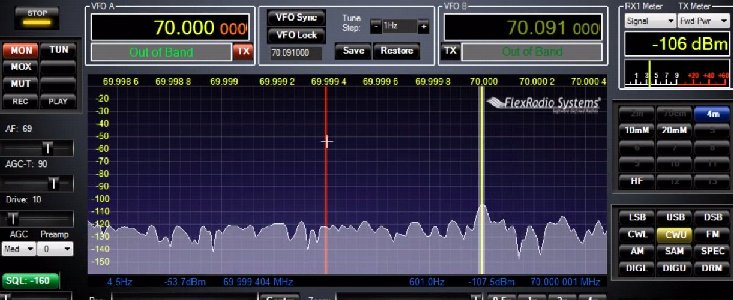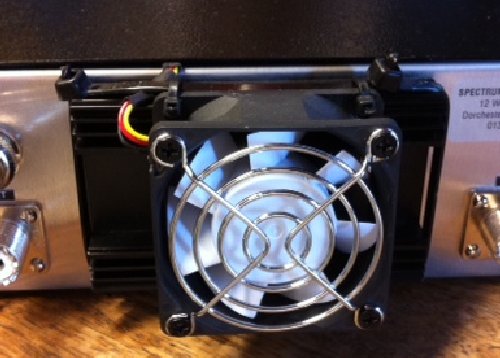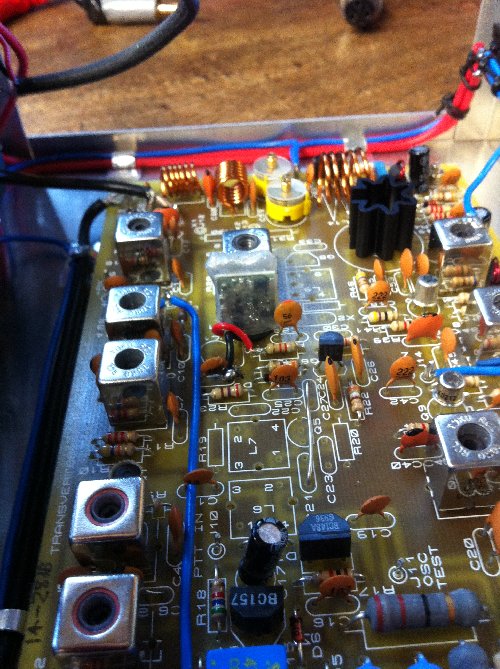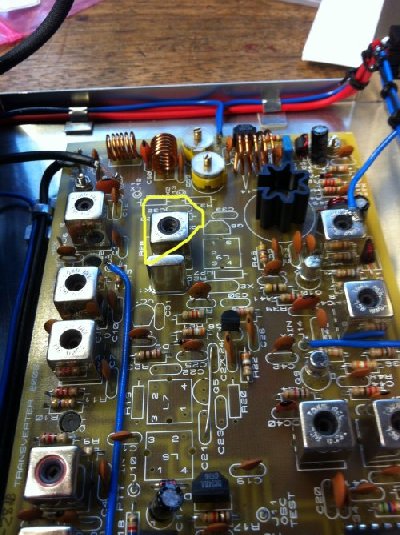The Spectrum 4M Transverter on Wspr
(Many thanks to
GM4FVM and M0NKA who worked with me on my transverter as
well as on their own)

Please
Note: Ongoing Experiment. Duplicate At Your Own
Risk!
This project is definitely at the
experimental stage. Only time will tell if results can be
duplicated with this particular transverter in the coming
weeks, let alone on other similar Spectrums. For instance
temperature in the shack varies from <-5 degrees in
winter to >30 degrees in summer, this doesn't help.
The Spectrum 4m Transverter is a common
way to get yourself onto 4m in the UK. It was designed for
FM/SSB use and does a fine job, it did find Wspr a bit of a
challenge however. Frquency stability of <4hz is required
over a 2 minute period, throw into this refections/doppler
common on 4m and stability of <2hz is preferable.
There are currently no multimode 4m tranceivers produced commercially so a transverter is the logical step. Fortunately for me I also own a Yaesu FT847, which was a commercially produced multimode transceiver (well sort of). However these are no longer produced and I like to have a back up plan. Once I acquired a Flex 1500 I decided it was time to sort out my Spectrum for use on the more demanding mode of Wspr.

Use inductor L8 (circled) to calibrate your Spectrum against a known source.
Issues with the Spectrum for Wspr.
1) Drift - upon warm up. This can be relatively annoying but not insurmountable. Mine changed by around 400hz
2) Drift - once warmed up. This can be as much as 100hz or more over time. More than annoying as tthe Wspr window in only 200hz wide, so a drift 0f 50hz either way is the limit realistically if the signal is not placed precisely in the middle of the allocation.
3) Drift - during transmission. Fatal if you want to be spotted. Over 4hz and even if you are a very strong signal, you probably won't be decoded.
4m spots can be rare. It is a shame when you do have the opportunity to spot, for it to be wasted because of the above.
The Cause?
The likely culprit is temperature change.
To be fair to The Spectrum it is a fine transverter for SSB/FM use, around which it was designed. Mine was built for me and is nicely finished. However the three types of drift above make this unsuitable for Wspr use in its unmodified form. Don't get me wrong, it can be used this way if you get lucky, I have done so, but the chances of making the elusive spot you have waited many weeks for are almost zero. The problem is simple: Heat.
Heat circulates freely inside the closed case of the ready built model. This heat causes changes to the operating temperature of the oscillator. For Wspr you need to have the oscillator as stable as possible. Heat, or rather heat changes, damage your propects of stability.
Solution to Drift 2 (credit to GM4FVM who suggested this improvement)
The single biggest improvement is the addition of a fan to the heatsink. This immediately solved most of the second version of drift. I tried several fans but settled on a 6cm fan blowing towards the heatsink. After warm up the drift was reduced to no more than 25hz. This made the transverter very useable and my spot percentage shot up. The fan was £4.99 post free from Ebay. Just look for PC Cooling fans of 60mm. I cabletied it to the heatsink and took power from the transverter itself. A really simple fix especially for summer use.

Note fan is set to blow towards the heatsink, this proved more effective and the case remains cold. A guard has been ordered!

The cure here was aimed at stabilising drift during transmission when the heat inside the case rises.
I fitted a Kuhne Xtal heater to the crystal: Kuhne QH 40a Easy to order, just contact them via the site and use Paypal to the account they send. It arrived in a few days. Cost delivered was approximately 16 Euros.
This maintains the crystal temperature at arund 40C. Although performance of the heater cannot match that of a true ovenised oscillator, a stable crystal temperature can only help oscillator stability.
Result: My 'worms' became somewhat flatter indicating reduced drift during the 2 minute transmission period.

QH 40a in original position - It is now fed by 12v direct from a voltage regulator and is better insulated see update below.
Improvement to Drift 1
If I leave the transverter powered for 10 mins before going on the band I can use it without correction. This allows the crystal heater and other components to settle. It still takes an hour or so to reach optimum stability. The Transverter may never quite match my FT847 in terms of stability. It is though quite serviceable even with the demands of Wspr.
Note:
The Flex 1500 driving the transverter is very stable, I have a Rubidium 10mhz source to assist when necessary. This is important otherwise there would be more than one variable to contend with. I now have a transverter calibrated against GB3BUX that APPEARS useable day after day without the need to worry that it might not actually be on frequency.
Only time will tell.
Update
Further experiment appears to have improved stability over the two minute tx period required by Wspr. I removed the crystal and the Kuhne heater. Using cpu cooler thermal paste and glass wool isulation (straight out of the loft) I improved the position/bond and insulation of the heater. This was then sealed with heatshrink tubing of a larger diameter that that provided by Khune. I replaced the whole thing and upped the voltage (to the heater) to 12v using a regualltor (the upper end of its range). The drift over two minutes is now less than 1hz, usually ZERO.
Conclusion. The Kuhne heater would appear to be a worthwhile purchase. Take care to drive it with a regulated 12v supply and insulate to get the best out of it. The Spectrum has been in use for several weeks and is a stable as anything out there provided the driver radio (I have been using an FT-897 with TCXO fitted of late) is stable, the combination is plug and play for Wspr use.
Home
There are currently no multimode 4m tranceivers produced commercially so a transverter is the logical step. Fortunately for me I also own a Yaesu FT847, which was a commercially produced multimode transceiver (well sort of). However these are no longer produced and I like to have a back up plan. Once I acquired a Flex 1500 I decided it was time to sort out my Spectrum for use on the more demanding mode of Wspr.

Note: all of the
information below assumes you have a reference to
calibrate your radio against. I use GB3BUX
(see above).


Use inductor L8 (circled) to calibrate your Spectrum against a known source.
1) Drift - upon warm up. This can be relatively annoying but not insurmountable. Mine changed by around 400hz
2) Drift - once warmed up. This can be as much as 100hz or more over time. More than annoying as tthe Wspr window in only 200hz wide, so a drift 0f 50hz either way is the limit realistically if the signal is not placed precisely in the middle of the allocation.
3) Drift - during transmission. Fatal if you want to be spotted. Over 4hz and even if you are a very strong signal, you probably won't be decoded.
4m spots can be rare. It is a shame when you do have the opportunity to spot, for it to be wasted because of the above.
The Cause?
The likely culprit is temperature change.
To be fair to The Spectrum it is a fine transverter for SSB/FM use, around which it was designed. Mine was built for me and is nicely finished. However the three types of drift above make this unsuitable for Wspr use in its unmodified form. Don't get me wrong, it can be used this way if you get lucky, I have done so, but the chances of making the elusive spot you have waited many weeks for are almost zero. The problem is simple: Heat.
Heat circulates freely inside the closed case of the ready built model. This heat causes changes to the operating temperature of the oscillator. For Wspr you need to have the oscillator as stable as possible. Heat, or rather heat changes, damage your propects of stability.
Solution to Drift 2 (credit to GM4FVM who suggested this improvement)
The single biggest improvement is the addition of a fan to the heatsink. This immediately solved most of the second version of drift. I tried several fans but settled on a 6cm fan blowing towards the heatsink. After warm up the drift was reduced to no more than 25hz. This made the transverter very useable and my spot percentage shot up. The fan was £4.99 post free from Ebay. Just look for PC Cooling fans of 60mm. I cabletied it to the heatsink and took power from the transverter itself. A really simple fix especially for summer use.

Note fan is set to blow towards the heatsink, this proved more effective and the case remains cold. A guard has been ordered!

With guard. Now my fingers are safe.
Solution to Drift 3The cure here was aimed at stabilising drift during transmission when the heat inside the case rises.
I fitted a Kuhne Xtal heater to the crystal: Kuhne QH 40a Easy to order, just contact them via the site and use Paypal to the account they send. It arrived in a few days. Cost delivered was approximately 16 Euros.
This maintains the crystal temperature at arund 40C. Although performance of the heater cannot match that of a true ovenised oscillator, a stable crystal temperature can only help oscillator stability.
Result: My 'worms' became somewhat flatter indicating reduced drift during the 2 minute transmission period.

QH 40a in original position - It is now fed by 12v direct from a voltage regulator and is better insulated see update below.
Improvement to Drift 1
If I leave the transverter powered for 10 mins before going on the band I can use it without correction. This allows the crystal heater and other components to settle. It still takes an hour or so to reach optimum stability. The Transverter may never quite match my FT847 in terms of stability. It is though quite serviceable even with the demands of Wspr.
Note:
The Flex 1500 driving the transverter is very stable, I have a Rubidium 10mhz source to assist when necessary. This is important otherwise there would be more than one variable to contend with. I now have a transverter calibrated against GB3BUX that APPEARS useable day after day without the need to worry that it might not actually be on frequency.
Only time will tell.
Update
Further experiment appears to have improved stability over the two minute tx period required by Wspr. I removed the crystal and the Kuhne heater. Using cpu cooler thermal paste and glass wool isulation (straight out of the loft) I improved the position/bond and insulation of the heater. This was then sealed with heatshrink tubing of a larger diameter that that provided by Khune. I replaced the whole thing and upped the voltage (to the heater) to 12v using a regualltor (the upper end of its range). The drift over two minutes is now less than 1hz, usually ZERO.
Conclusion. The Kuhne heater would appear to be a worthwhile purchase. Take care to drive it with a regulated 12v supply and insulate to get the best out of it. The Spectrum has been in use for several weeks and is a stable as anything out there provided the driver radio (I have been using an FT-897 with TCXO fitted of late) is stable, the combination is plug and play for Wspr use.
Home